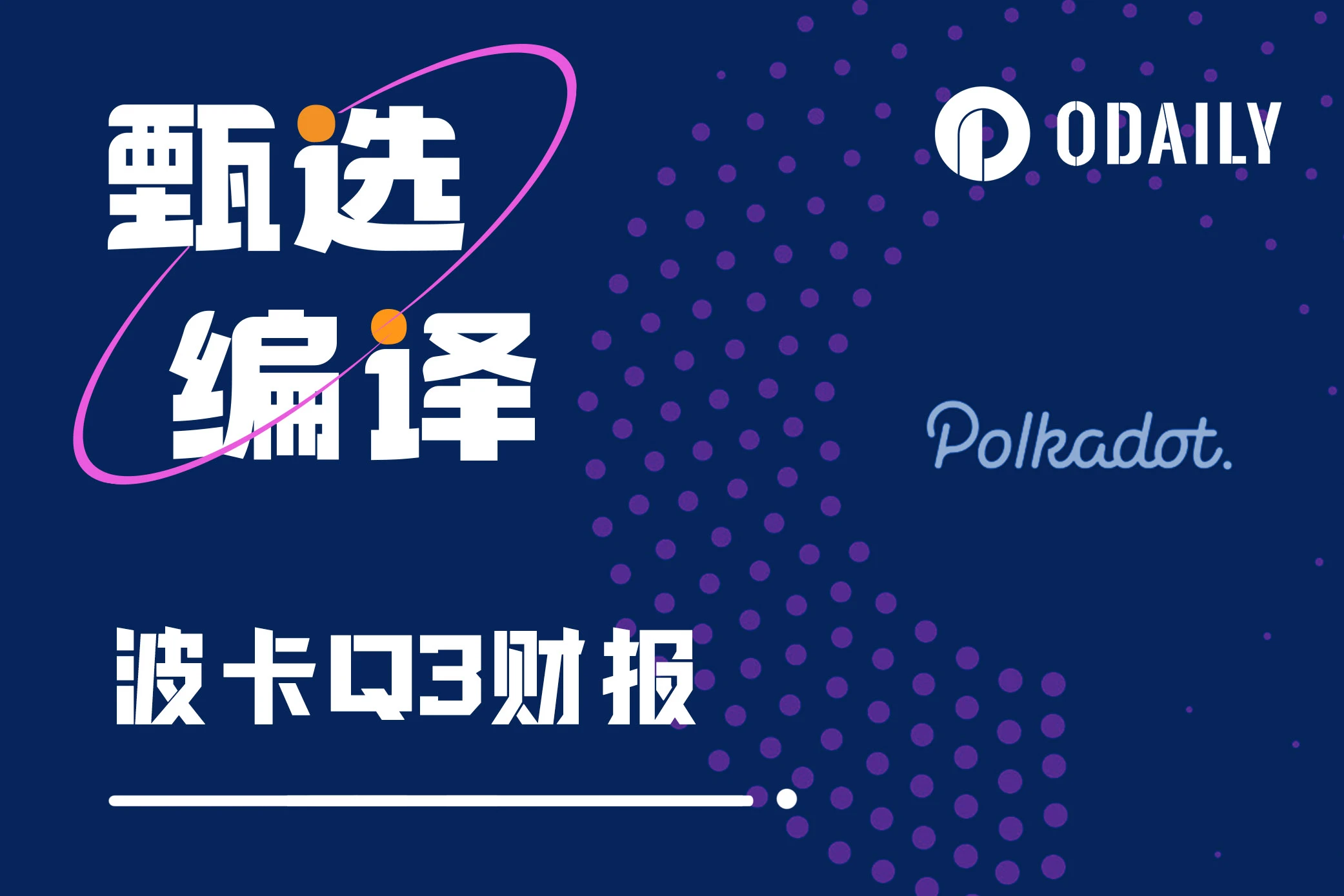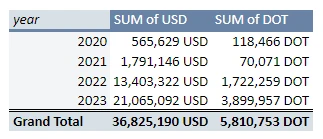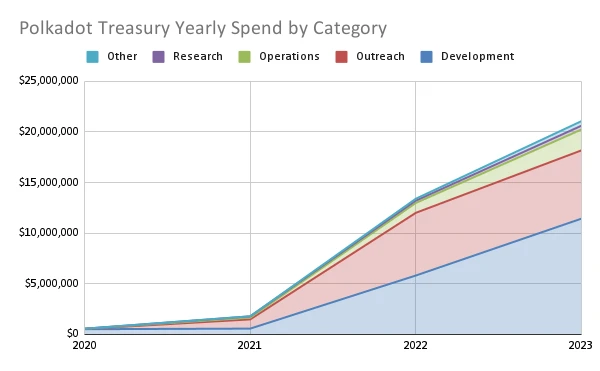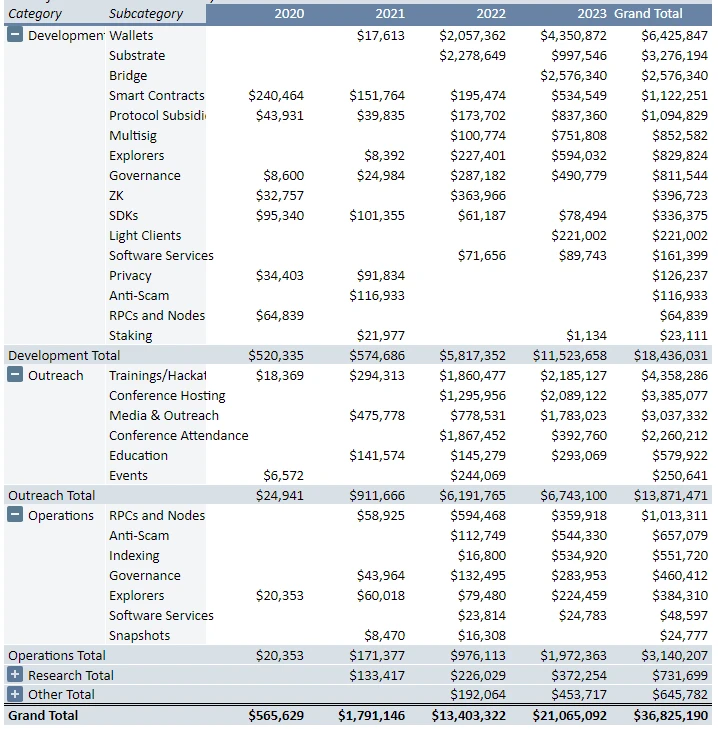Compile - Odaily
Translator - Azuma

On October 19, Polkadot community researcher Alice und Bob released Polkadot’s Treasury expenditure report for 2023 in the governance forum. The report data was compiled by herself based on community proposals and Treasury fund flows. The content covers Treasurys specific expenditures and classification statistics as of October 18.
The following is the full text of the report, compiled by Odaily.
Overview
2023 is not over yet, but we have already seen a significant increase in both DOT and USD payouts from the Treasury compared to 2022. Year-to-date, the Treasury has allocated a total of approximately 3.9 million DOT, or approximately $21 million, while expenditures during the same period in 2022 will be approximately 1.7 million DOT, or approximately $13 million.

Spending categories
In this report, we summarize all expenditures into four major categories: Development, Outreach, Operations, and Research. Some additional expenditures are unified into other categories.
“Development” spending primarily includes funding for various software developments;
Operation expenses mainly include software and hardware costs incurred in operating and maintaining the network and related ancillary services (such as browsers);
“Promotion” expenditures mainly include all expenditures related to media marketing, social activities, and educational activities;
“Research” expenditures primarily include the costs required to complete various types of studies, reports and analyses.
Compared with 2022, spending on development and operations has doubled, promotion spending has increased by less than 10%, and research spending has increased by about 65%.


Horizontal comparison
Comparing the four major expenditure categories horizontally, development accounts for nearly half of the expenditure, promotion accounts for 38%, operations accounts for 9%, and research and others only account for about 2%.

However, if we compare vertically the changes in the proportion of various types of expenditures in the past few years, we can see that the relative importance of various types of expenditures (i.e., the proportion of expenditures) has not fluctuated greatly, which to a certain extent shows the progress of ecological development. stability.

More micro subcategories
After researching the proposal, we decided to look at Polkadot’s spending from a more micro perspective. Next, we will continue to split into multiple subcategories within the above four major categories to see more specific amounts and proportions (Odaily note: there is some overlap in the expenditures of each subcategory).

The first is the “development” category, where Polkadot has spent a total of $18 million so far (not just in 2023), accounting for 50% of all total spending.
Funding for wallet development totaled $6.4 million, making it the largest spending subcategory;
The total funding for Substrate-related development (such as clients and development tools) is US$3.3 million;
A total of $2.6 million has been allocated to cross-chain bridge development;
Funding for smart contract support (mainly the Ink! language) is $1.1 million;
Funding for multi-signature tool development is $850,000;
Block explorer development funding is $830,000;
Governance tool development funding is $810,000;
The total amount of subsidies in the agreement is US$1.1 million, including expenditures on public affairs and subsidies for regular ecological projects;
Several other development efforts were also funded, such as ZK, SDKs, light clients, privacy, fraud prevention, RPC and staking, etc., with expenditures totaling approximately $1.4 million.
This is followed by the “promotion” category, with spending in this area totaling $14 million to date, accounting for approximately 38% of total spending. Within this category, it is often difficult to divide the detailed expenditures again because there is always a large overlap.
The largest expenditure items include hackathons, development training, online conferences, incubators, etc., with a total expenditure of US$4.4 million;
A total of US$3.4 million was spent on organizing ecological conferences (such as Decoded and Sub0);
Spending on media promotion and education activities totaled $3.6 million;
The total expenditure for participating in the conference on behalf of Polkadot was US$2.3 million;
The total funding for events (mainly parties) is $250,000.
Then there is the “Operations” category. Although the operation of the Polkadot network is paid through staking rewards (up to $46 million per year) rather than Treasury, the creation of auxiliary services for ordinary users still consumes a total of $3.1 million in expenditures. , accounting for 9% of the total cost.
A total of $1.6 million was spent on RPCs, nodes, and indexing services;
Spending on governance tools and other browsers was $840,000;
Anti-fraud work resulted in a $660,000 bonus;
Expenses related to software services and snapshots were $72,000.
Finally, there is the research aspect, with overall associated costs totaling $730,000.
Half of the expenditure ($350,000) was paid to Messari to commission the latter to conduct original research. These research reports can be completed by an intern or ChatGPT in two months... (Alice und Bobs original words, it seems I am quite dissatisfied with this expenditure...)
Other expenditures include multiple studies related to decentralization, validator selection, candle auctions, network carbon emissions, legal guidance, and data tools.
Summary and Outlook
Alice und Bob concluded that the data for this report comes from crawling and manual classification of Treasury expenditures.
Alice und Bob continued to express the hope that this report can help the Polkadot community better understand ecological expenditures in the past few years, provide a reference for future decision-making and budget considerations, and find more effective fund allocation solutions.
In addition, Alice und Bob also suggested that Polkadot build a dedicated budget and expenditure tracking infrastructure so that the community can understand the relevant situation more clearly and improve the efficiency of discussion and decision-making on specific topics.










